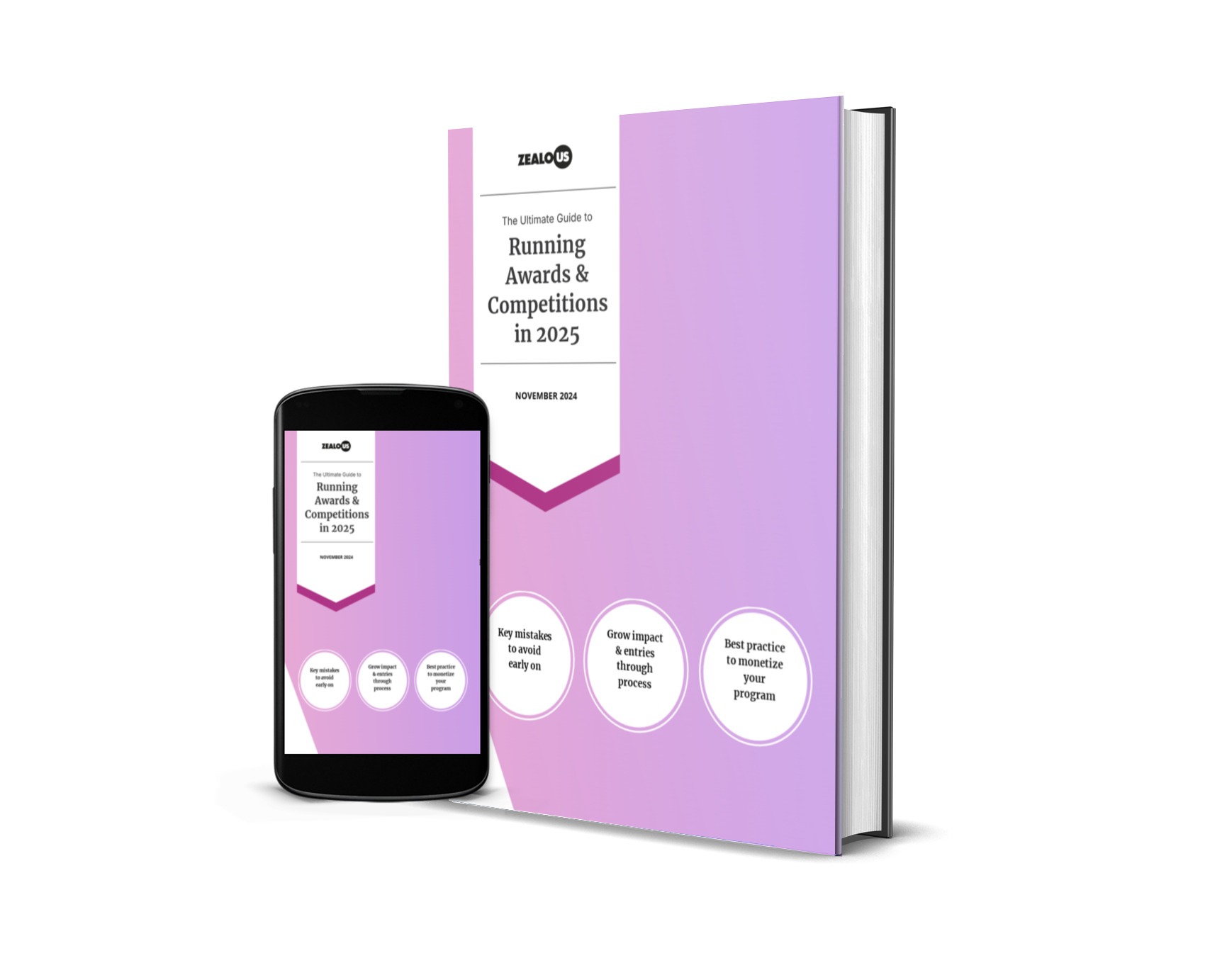This article covers:
- What to consider when choosing your process
- What tools are available to you
- How it all fits together
- Things to be careful of
The Overview
When choosing an award management platform or setting up your submissions process, many organizations focus only on how candidates will submit. But only focusing on this single area is likely to waste a lot of your time later in the award management process.
Other things you should consider are.
How will:
- Candidates submit (default)
- Candidates pay the submission fee
- Candidates know about my opportunity
- We measure progress on submissions
- We administrate entries once submissions close
- We make our selection
- We present the information to our judges
- We capture scores from our judges and process them
- It all fit together (integration)
- We afford it
Award Management Platform vs. DIY Solutions
Before diving into specific tools, it’s worth understanding the fundamental choice you’ll face: using a dedicated award management platform versus piecing together separate tools.
DIY Solutions involve combining separate tools (forms, payment processors, spreadsheets, email) to create your own system. While initially cheaper, this approach often becomes time-intensive and error-prone as your program scales.
Dedicated Award Management Platforms offer integrated solutions that handle the entire award lifecycle – from submissions and payments to judging and reporting. These platforms are specifically designed for awards, competitions, and grants management.
The choice depends on your program size, budget, and how much time you want to spend on administration versus focusing on your awards program itself..
Taking Submissions
How you choose to accept submissions is the most vital step, the information you capture when a candidate submits an entry will inform the rest of your process.
You do not want to find yourself flooded with entries and realise you do not have the correct data to make a good decision later on. Missing data at this step will lead to an explosion of emails to candidates and a need to clean all the data submitted manually.
The ideal process will ensure your data is structured enough to process entries simply but give the candidate enough flexibility to let their uniqueness shine.
Here are a couple of processes we have come across when accepting entries.
Submissions via Social Media
Submitting an entry through a hashtag on social media is perhaps the process that requires the least effort from candidates.
Social media is the dirtiest in terms of data (what if someone spams your hashtag?), and you won’t be able to effectively capture any data points from candidates other than basic unstructured posts.
Social media is also the medium to market your programme and could lead to many entries, but you’ll likely need to pay for candidates to see your post.
Without a direct email, you will need to communicate with candidates publicly or use the platform’s built-in messaging feature (one message at a time). Social media networks have restrictions on sending direct messages to non-followers.
Social media might be the right choice if you want a quick way to run a simple competition without a fee (e.g. a giveaway). The medium may also work in your favour for a public vote, but you’ll have no way to restrict who can give their opinion here.
Best for
- Quick giveaways
- Competitions with little structured data (e.g. a single image)
- Public votes with lax requirements (e.g. allow duplicate votes)
- Amplifying exposure to a programme you are running elsewhere
- Boosting social engagement
Avoid if you
- Want more data than just a set of images/videos and a description
- Want data for reports you won’t need to clean yourself
- Need contact details
- Have external judges
- Want to select candidates in rounds
- Take a fee for entering
- Expect exposure for free – you’ll need to pay to be seen
- Reduce manual work – Tracking and monitoring what posts you’ve seen/not seen and avoiding missing anything due to human error
Getting more submissions
Being seen is key to getting as many submissions as possible.
As well as social media tools, some of the tools you pick to manage entries may give you some marketing for free through their existing networks. This little extra push could help supplement your marketing efforts and grow the impact of your programme.
However, getting seen isn’t the only thing that will help you grow the number of submissions; making sure people complete the process of submitting once they have found you is equally (if not more) important.
If the application process is set up well and easy enough for the candidates, if nine out of ten people submit successfully instead of nine out of a hundred, you will save lots of money on marketing your programme.
Keeping the submissions process as unified as possible and measuring where candidates are dropping out will allow you to tweak your submission process to improve your success rate.
If you are manually running your call across multiple platforms, you may also consider creating emails to remind candidates to complete their submission a few days before.
Submissions via Emails / Word Documents
Getting candidates to email their entry is a popular option. This solution is cheap and makes communicating with candidates easy.
Emails provide you with the flexibility of receiving files (such as images, documents, etc.); this will allow for the candidates’ creativity to shine. It is important to note that all attachments together cannot be more than 25Mb. WeTransfer could offer you a solution to generate links to large files, but this is another step the candidates need to take when submitting (leading to more dropouts).
Emails offer you limited tools to validate the data candidates are submitting. You could provide them with an application form e.g. Word or PDF… but you will still need to double check if they provided answers to all the mandatory questions each time an email graces your inbox.
Candidates having your email address will lead to queries coming to the same inbox as completed entries. You will need to triage submissions from questions constantly to have a clear view of progress in your inbox.
Emails allow for a degree of administration – you could create folders to drag successful entries into (a folder for each round of selection, or all successful candidates), and communicating with candidates will be simple since you know you have a working email address.
Getting candidates to pay a fee will require you to link to a payment platform which will need you to keep track of the payment status of each applicant and move them in the correct folder as they pay. After you’ve checked that you have received your payment, you will now need to manually collate all the applicable (paid) entries together so they can be read and assessed by yourself or judges through folders or producing presentation documents, this would be another step in the process for you when collating entries (more time administrating entries).
Best for
- Programmes with very few entries
- Limited budget
Avoid if you
- You expect more than 30 entries
- Want data you won’t need to clean yourself
- Need larger files (the emails will bounce with large attachments)
- Have external judges
- Take a fee for entering
- Want to select candidates in rounds
Email overheads
Managing incoming queries from candidates is one of the most time-consuming tasks in managing any programme.
There are many reasons a candidate might contact you:
- Confusion around the process
- Clarify what they need to submit
- Edit an entry they sent you
- Confirm they have submitted
- Confirm payment / Request a refund
- Check on results
- Dropping out
It is impossible to remove email overheads when running a programme, but you can ensure you receive a lot less by:
- Choosing the most painless process… e.g. Paying a fee by Paypal and then getting entrants to fill in a form they need to download and then email – Sending them from one service to another is likely to lead to confusion.
- Updating your guidelines as you go to include answers to the most popular questions; ensure candidates need to read them before they submit.
- Choosing a tool… Allow them to save drafts and edit them
- Allow candidates to remove their entry without needing to contact you.
- Pick a tool that automatically emails candidates confirming they have submitted or they’ve been selected to the next round (or use auto-responders in email inboxes, have email templates to confirm a submission (and/or payment) was received).
Submissions via Online Forms
Online forms are the default go-to tool when taking submissions for the first time. Forms are a relatively cheap and efficient way of ensuring applicants provide you with the information you need in a structured format.
Most forms will allow you to upload attachments too (likely with small upload sizes; or the need to integrate with Dropbox).
Some online forms may provide you with the ability to capture payments upon applying. If you take fees from candidates, be sure to check before committing to a specific platform since not all online forms allow for payments.
Forms work well for accepting the entries but not so well for managing entries and making your selection. They won’t present entries visually, and you’ll need to export data to a different platform to process them efficiently. It is also worth noting that forms don’t include tools to communicate the results with candidates, make your selection across rounds, score entries, draw up reports, etc.
Best for
- Medium-sized competitions with simple processes (150 entries max)
- Small programmes with more complex selection criteria (80 entries max)
- Embedding your form directly into your webpage
Avoid if you
- You expect more than 150 entries
- Need a tool to score entries from one place, especially for external judges
- Take a fee for entering (or make sure the form you use allows you to take payments)
- Have special deals on fees
- Want to select candidates in rounds
While general online forms work for basic programs, dedicated award management platforms offer superior functionality for scoring, judge collaboration, and multi-round selections that most awards require.
Taking fees/donations
If you opt to take a payment from candidates, you’ll need to integrate the payment flow into the submission process.
Choosing to receive submissions on a platform that doesn’t allow for payments (e.g. social media, via email, or some online forms) will create a need to send candidates to a platform to make the payment, then send the candidate to a different platform to submit. This back-and-forward will add to your workloads and slow down the candidates when applying (especially during those final moments before submissions close or when payments bounce!)
Organisations who choose this flow will usually take the payment up-front before the candidate can submit since it is easier for them to administrate (taking payments after means additional steps and more submissions to process).
However, taking payments upfront leads to a deeper drop-off early in the process, which means fewer submissions. Candidates are more likely to pay once they have invested time in their application (the reason the payment step is always the last in most online services). It is also more ethical to do so since they always pay for submissions they actually make (taking the payment first could lead them to pay but forgetting to submit).
Finally, putting the payment step at the end of your process will allow you to capture contact details before candidates drop out and keep their draft. You could contact anyone who dropped out at the payment step and offer them support (technical, financial, any last-minute queries about the guidelines etc)
Be mindful that making candidates submit in one place and pay in another adds significantly to your workloads and lead to far fewer successful submissions.
Award management platforms typically integrate payment processing seamlessly into the submission flow, eliminating the need for candidates to navigate between multiple systems.
Building your own software
Before considering building custom software, most organizations should thoroughly evaluate existing award management platforms. Modern award management software often provides the functionality you need without the development costs and ongoing maintenance requirements. But if you want a truly bespoke solution and you have the budgets, read on.
Building your system to manage entries might be a viable option with the correct budget. Bespoke software will give you total control over your process.
However, this panacea will come at a hefty cost and may not be as perfect as it seems.
Most organisations see building software as projects with an end date (like building a house). Thinking of software as a project with an end date is dangerous. Software must be maintained and evolved to function in an environment where technology changes quickly (this holds especially true when integrating your code with other platforms). Make sure you consider how much it will cost you to have some development available beyond the initial deployment.
Things you will need to consider when you go bespoke are:
- Draw up a tight set of requirements. Do you want to be able to offer unlimited file sizes to entrants so they can really showcase their submission fully? Would you like judges to score on the platform, would you like to be able to download data?
- Will your outsourcing company also offer technical support if applicants and judges need any help with the platform?
- What budget do you need to set aside should you need to incorporate new functions or upgrades?
- Be mindful your requirements are likely to evolve and need tweaking. Have that flexibility written into the contract you have with your developers.
- Make sure you budget the upfront price of building the platform, as well as the monthly costs once you go live (support, hosting, systems administration, running costs, etc.)
- Choose good developers which you can keep to maintain and improve your code beyond going live.
- Count a minimum of 6 months to your first deployment (planning, developing, testing, etc.). Plan to go over your deadline by about 25%.
- Make sure your infrastructure is scalable – the software may work under test conditions, but what does it look like when 1,000 people submit at once?
- Ensure your data and system are secure and GDPR compliant. Especially important for sensitive data – like payment details, contact details, etc.
- Understand that compliance around payments changes all the time, and build that flexibility into your platform.
Best for
- Very large recursive competitions with bespoke needs
- Those with large budgets
- Long ramp-up time before the programme is run
Avoid if you
- You haven’t exhausted all the other available products first
- Want to focus on your programme, instead of the tech
- Your budgets are tight
Judging & Processing Entries
As mentioned previously, it is dangerous to focus solely on how candidates can submit without thinking about how entries will be processed.
Each organisation will have its unique way to select successful candidates; you might:
- Invite internal and external judges to give their opinions
- Select candidates in rounds (e.g. shortlists)
- Require candidates to provide you with more information if they are successful.
- Have score cards judges need to fill out (e.g. best picture, best actor, etc.)
Manually performing these tasks requires you to manage email overheads with judges, compile pdf files, put content on shared drives and resort to large, complex spreadsheets. You may also consider printing all entries and sending them physically to those scoring entries.
These tasks are time-consuming, prone to error, can be detrimental to the environment and may end up costing you more than you thought (shipping, printing, employing someone, etc.)
It is also vital to think about the judges’ experience. The more documents and programs you integrate into your selection, the more complex the process becomes for them. Jumping backwards and forward from shared drives to spreadsheets to emails containing instructions is time-intensive and shifts the judges’ attention away from the content of the entries to be scored.
Most modern award management platforms solve these challenges by providing integrated judging portals where all scoring, collaboration, and decision-making happens in one place. But be sure to test them out first since every click you judge makes counts! The experience needs to be seamless.
Saving judges 6 seconds on each entry will save them 10 minutes on a call with 100 entries.
Making the judging process as simple as possible helps ensure the judges can focus on the entries and shows respect for their time (especially for busy judges who are giving their time for free).
Choosing the Right Award Management Platform
If you’ve decided that a dedicated award management platform is right for your program, here are key features to evaluate:
Essential Award Management Features:
- Integrated submission forms with file upload capabilities
- Built-in payment processing for entry fees
- Judge portal with scoring and collaboration tools
- Multi-round selection capabilities
- Automated email communications
- Reporting and analytics dashboard
- GDPR compliance and data security
Some Questions to Ask Platform Providers:
- How does the platform handle large file uploads for creative submissions?
- Can judges access and score entries from any device?
- What payment methods are supported for entry fees?
- How does the platform prevent duplicate voting in public votes?
- What kind of customer support is provided during peak submission periods?
The right award management platform should simplify your entire process, from initial submissions through winner announcement, allowing you to focus on your program’s impact rather than administrative tasks.
Conclusion
Your success depends heavily on your choice of tools and how they integrate with each other. Picking the right ones at the start of your journey will empower you to invest time in growing your programme instead of being bogged down in administrating it.
“Give me six hours to chop down a tree, and I will spend the first four sharpening the axe”
Abraham Lincoln
Let us know you want us to write more content like this with a love!
Share

Guy Armitage is the founder of Zealous and author of “Everyone is Creative“. He is on a mission to amplify the world’s creative potential.




